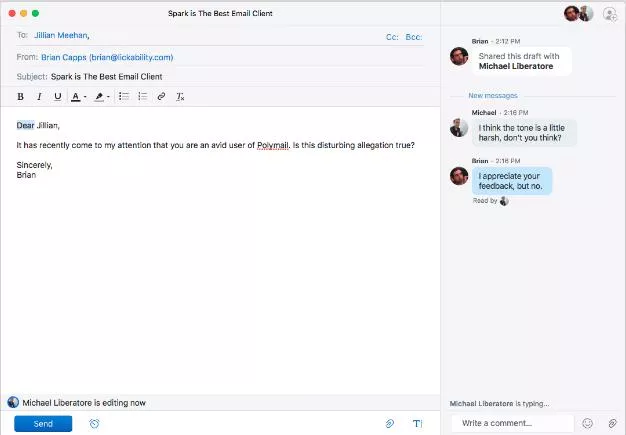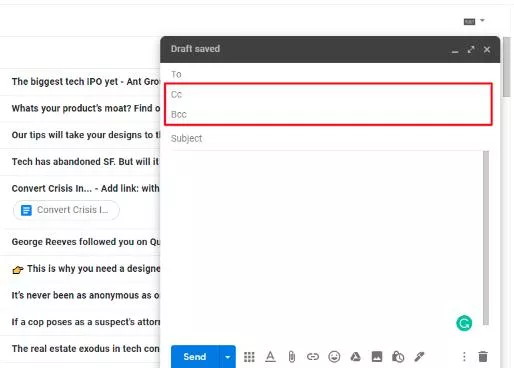What is CC in Email? Learn More Now
CC in email is used to update others without receiving any reply from them. You can use it to keep your clients, coworkers, and customers updated. CC in email means carbon copy. It sends multiple copies of an email to different email addresses to inform or update them with your mail.
CC field is situated right under the "to" field. The steps to send a CC are as follows: open your email box and start writing one, and you will see a field of "to", and right under it, you will see the "CC" field. Put all the email addresses of those you want to know about your mail, write the mail, and select the "send" button. You can only receive a reply from the email address that you mentioned in the "To" field.
What is CC in Email Meaning?
- Carbon Copy is referred to as CC.
- For contacting numerous people, use CC.
- CC is required by proper email protocol.
Email Collaboration With CC is Possible

The origins of the term "CC" in the email go all the way back to the very first era of electronic communication. CC is for carbon copy, which refers to the practice of utilizing carbon paper to duplicate handwritten and typed letters. CC was adapted as a technique to send multiple copies of the same email to different email addresses in order to just provide users with a word they were familiar with.
In an email, the "To" field and the "CC" field basically work together. The "To" field is filled up with your primary recipient, or the "CC" field is where you can add any additional receivers you desire to include in the discussion. By adding contacts using the CC feature in your emails, you can keep everyone informed about anything from meeting minutes to project briefs without them having to respond.
Examples of CC Emails: When to Use Them
Email etiquette or professional communication best practices both depend on understanding when to utilize CC in an email. You may exchange information using contacts without constantly having to forward emails after the fact, which can save you time. Here are a few of the most frequent justifications for using CC in an email.
Keeping Others Informed —
Keeping others informed is one of the most popular uses for CC, if a manager and colleague has specifically asked to be CC'd or you wish to share vital information with some other contact.
Forming a Contact —
Another typical usage of CC in emails is to introduce two of your contacts to one another. Create your introductory email first, and then list the contacts you want to use.
Internal Newsletters —
For sending internal newsletters and other bulk emails across major firms, the "CC" field is frequently used. It is frequently indicated that no response is necessary in these situations while using the "CC" field rather than the "To" field.
While sending emails, it's crucial to keep in mind not to overuse the CC function. It's also important to remember that the BCC field serves a different purpose. Keep in mind that CC is typically used to send information that doesn't always need a response. Furthermore, utilize CC as sparingly as you can to prevent spamming your contacts with pointless information.
Steps for Sending CC Emails

- The CC field is either next to or below the "To" field.
- To create a new message, click.
- Put email addresses in the CC area.
- Select send.
A CC email can be sent with ease, and the majority of people are already familiar with how to use one. Typically, the "CC" field appears in your email composing window just above the "BCC" field or below the "To" box. Simply enter your principal contact's information in the "To" area, followed by the contacts you want to discuss the thread within the "CC" field. While utilizing both CC and BCC simultaneously, you must always double-check that the relevant contacts are listed in the right fields because sharing private email addresses with others can be troublesome.
Dos and Don’ts
Dos
- To keep people informed, use CC. If you don't require a response, it works best as an FYI.
- To include people in an email thread or message, use the CC function.
- To introduce two or more people, use CC. This makes it possible to exchange contact information without needing your participation in the conversation.
- When you want to address the whole group in a CC email, use the "reply all" function.
- Share news, events, and newsletters to your coworkers using CC.CC
Don'ts
- With CC, avoid being passive-aggressive. You shouldn't immediately CC the boss if you haven't received a response.
- Avoid using CC to micromanage teams or employees. When every message gets CC'd, the office atmosphere becomes oppressive and challenging to control.
- If someone wants to stay anonymous or keep their contact information private, don't CC them when sharing their email address.
- In CC emails, avoid clicking "reply all!" if you wish to talk to a contact in private.
- If you are sharing events, announcements, or newsletters with individuals outside of your firm, avoid using CC.
- Published by: Mick
- Category: Email
- Last Update: 6 days ago
Featured Blog
How to Fix Error Code csc_7200026 on AliExpress
Dec 8, 2025How to Cancel Your Club Pogo Account
Dec 8, 2025DuckDuckGo Not Working? Why & How to Fix it
Dec 8, 2025How to Register a Supercell ID Account?
Dec 8, 2025Spot Geek Squad Scams: Safety Tips 2025
Dec 8, 2025Top Questions
How to Find Windows 10 Product Key 2025?
Dec 8, 2025How to Increase Wifi Speed in laptop Windows 10?
Dec 8, 2025How to Convert FireWire Connections to USB?
Dec 8, 2025How do I Unlock my Keyboard on Windows 10?
Dec 8, 2025How to Create a Roku Channel in 3 Steps?
Dec 8, 2025How to Fix Gmail App Keeps Crashing Problem?
Dec 8, 2025Categories
- OTT
- 616 ~ Articles
- Windows
- 491 ~ Articles
- 164 ~ Articles
- Browser
- 145 ~ Articles
- Laptop
- 72 ~ Articles
- Antivirus
- 40 ~ Articles

Top Searches in Email
How to Register a Supercell ID Account?
Dec 8, 2025Top 10 Emails without Phone Number Verification - Free Emails Services
Dec 8, 2025How to Login Charter.net (Spectrum) Email?
Dec 8, 2025How to Login Network Solutions Webmail?
Dec 8, 2025How to Get Email Notifications on an iPhone
Dec 8, 2025How to Sign into Bresnan.net (Spectrum) Email?
Dec 8, 2025How to Add Your Yahoo Mail Signature
Dec 8, 2025How to Fix Problems Signing in to AOL Mail
Dec 8, 2025Why am I not Receiving Emails on Zoho
Dec 8, 2025How to Login to Telstra Bigpond Email?
Dec 8, 2025